The National Oceanography Centre (NOC) is a marine science research and technology institution based on two sites in Southampton and Liverpool, United Kingdom. It is the UKís largest institution for integrated sea level science, coastal and deep ocean research and technology development.
The NOC is wholly owned by the Natural Environment Research Council (NERC) and was formed in April 2010 by bringing together the NERC-managed activity at the National Oceanography Centre, Southampton and Liverpoolís Proudman Oceanographic Laboratory.
The centre was set up to work in close partnership with institutions across the UK marine science community to address key science challenges, including sea level change, the oceansí role in climate
change, predicting and simulating the behaviour of the oceans through computer modelling, the future of the Arctic Ocean and long-term monitoring technologies.
Marine science national capability
The NOC provides the bulk of the UKís capability to meet the needs of the countryís marine research community.
National marine capability provided by the NOC includes Royal Research Ships, RRS
James Cook and RRS Discovery (which is due for replacement in 2014), deep submersibles, including the Autosub autonomous underwater vehicles (AUVs), advanced ocean sensors and other instruments.
Across its two sites, the National Oceanography Centre is responsible for the global mean sea level data archive, the UKís sea level monitoring system for flood warning and
climate change, the national archive of subsea sediment cores (British Ocean Sediment Core Research Facility), the National Oceanographic Library, which houses the nationally important RRS Discovery and HMS Challenger archives, and the UKís main facility for holding and distributing data concerning the marine environment.
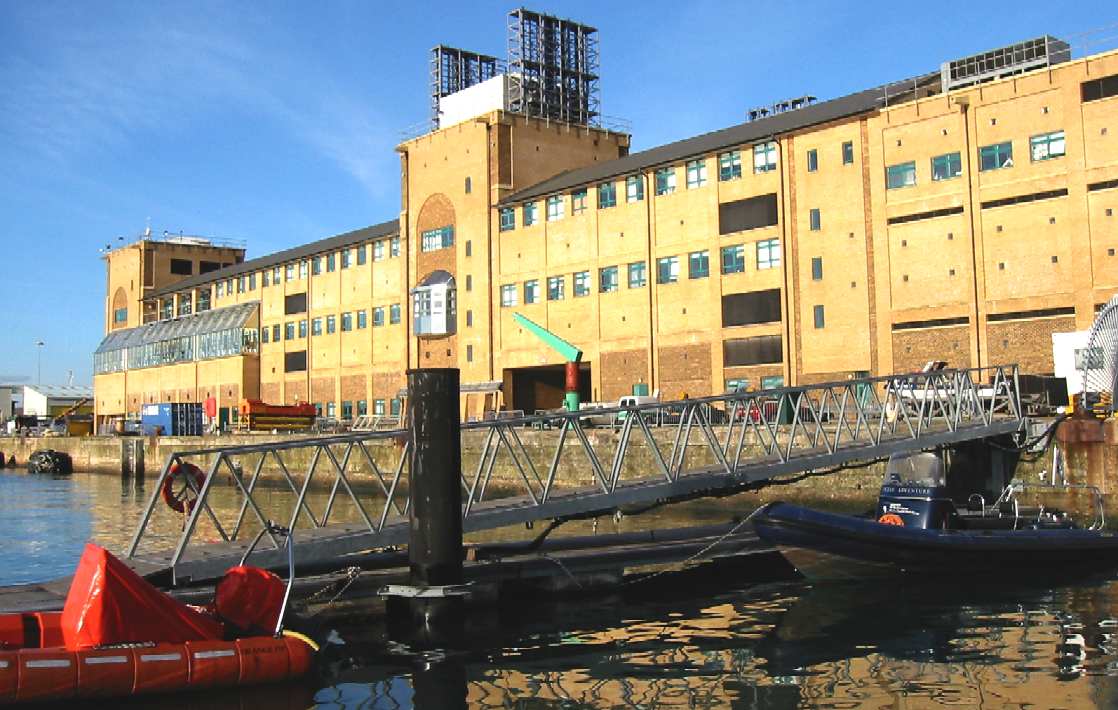
History
The National Oceanography Centreís waterfront headquarters were opened in 1996 by HRH the
Duke of Edinburgh, as the Southampton Oceanography Centre. It brought together the University of Southampton's departments of oceanography and geology with the Institute of Oceanographic Sciences, formerly based in Wormley, Surrey, and Research Vessel Services, formerly based in Barry Docks, South Wales.
It was renamed the National Oceanography Centre, Southampton in 2005, again by HRH the Duke of Edinburgh, its new name reflecting its prominence in ocean and earth sciences within the UK.
Until April 2010, the National Oceanography Centre, Southampton was jointly owned by the
University of Southampton and the Natural Environment Research Council. The term National Oceanography Centre, Southampton continues to be used to describe the collaborative relationship at the waterfront campus.
The National Oceanography Centreís Liverpool site, on the University of Liverpool campus, was formerly the Proudman Oceanographic Laboratory and specialises in tidal and sea level science. It hosts the National Tidal and Sea Level Facility, the Permanent Service for Mean Sea Level and the British Oceanographic Data Centre. It was formerly housed at the Bidston Observatory on the Wirral until before moving to the
University of Liverpool campus in 2004.
NOC Association
The NOCís partners include the University of Southampton, whose Ocean and Earth Science academic unit is co-located at the NOCís dockside headquarters, home to around 520 research scientists, engineers and technicians, ship operations and support staff, as well as around 700 undergraduate and postgraduate students. The University of Liverpool is the NOCís other hosting partner and postgraduate students are taught in a research-led environment in NOC's Joseph Proudman Building on the university's campus.
The NOC is responsible for managing UK marine science national capability. This includes provision of major facilities, programmes of sustained observing, survey, mapping, data management and other functions. The NOC also manages contracts placed by NERC with other organisations to provide some national capability functions. Such organisations are known as Delivery Partners and include:
* Plymouth Marine Laboratory
* Scottish Association for Marine Science
* Plymouth Marine Laboratory
* British Antarctic Survey
* British Geological Survey
* Marine Biological Association
* Sir Alistair Hardy Foundation for Ocean Science (named after Alistair Hardy)
The centre is committed to international engagement and has developed a range of international partnerships through the International and Strategic Partnerships Office, including an alliance of
Europeís three principal oceanographic research institutions with Ifremer of
France and IFM Geomar of Germany.
NOC, SOUTHAMPTON
The National Oceanography Centre, Southampton (NOCS) describes the integrated collaboration between the Southampton-based part of the Natural Environment Research Councilís National Oceanography Centre, and University of Southampton Ocean and Earth Science. The waterfront campus, on Southampton's Empress Dock, was opened in 1996 as the Southampton Oceanography Centre by Prince Philip (he also renamed it the National Oceanography Centre, Southampton, in 2005), NOCS is located near the Ocean Village development in the dock area of Southampton. It is one of a group of centres specialising in marine science, earth science and marine technology, and provides a platform for interdisciplinary research (such as the Autosub Under Ice programme) alongside a comprehensive teaching facility.
The NOCS comprises the University of Southamptonís Ocean and Earth Science academic unit which operates alongside five NERC research divisions and the NERC's National Marine Facilities Sea Systems . In addition to housing some 520 research scientists and staff, over 700 undergraduate and postgraduate students call the NOCS home. The NOCS's on-site resources include the UK National Oceanographic Library, the nationally important Discovery Collections and the
British Ocean Sediment Core Repository. The NOCS is also the base for the purpose-built research vessels RRS Discovery and RRS James Cook (and formerly RRS
Charles Darwin).
Prior to 1 May 2005, NOCS was known as the Southampton Oceanography Centre (SOC). The name was changed to reflect the Centre's prominence in ocean and earth sciences within the UK.
On 1 February 2010 the merger of NOCS and the Proudman Oceanographic Laboratory, Liverpool was announced. The combined institute is known as the National Oceanography Centre. The new combined centre brings together a full range of deep ocean and coastal oceanographic expertise.
On the 25th March 2010 an expedition aboard the RRS James Cook set out to study the world's deepest volcanic rift. On the 12th April it was reported the expedition had discovered the world's deepest undersea
volcanic vents, known as 'black smokers', 5,000 metres (3.1 mi) down in the Cayman Trough in the
Caribbean.
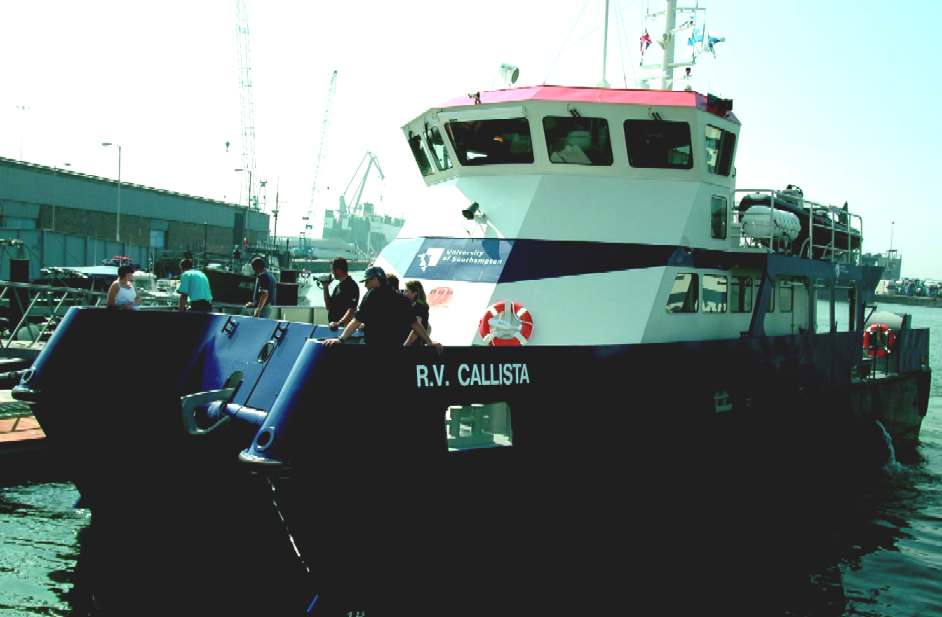
RV CALLISTA RESEARCH VESSEL OCTOBER 2005
RV Callista is also a product of the move towards consolidation, conceptualised as a shared resource with which all parties will 'work together as one'. Students at the School of Ocean and Earth Science will be the primary beneficiaries of the new craft, which has become operational just in time for the new academic year. Student fieldwork will be RV Callista 's priority but it will also be used by the NERC for research and the testing of marine research instrumentation which may then be fitted to its larger deepsea vessels. The vessel will also pay for its keep by being available for hire by commercial customers approximately six weeks of the year.
The 19.75m LOA aluminium hulled catamaran was built in
Finland by the Tyovene Oy yard following an international competitive tendering process.
Tenders were received from yards across Europe and other continents but the decision went to Tyovene Oy on the basis of quality, specification and price. The yard had recently delivered boats to
Sussex Sea Fisheries and the Irish Coastguard. These vessels were visited and inspected by a University team, which was impressed by the yard's exceptionally high build standards. An extensively detailed specification listing everything the boat would require when operational was included on Tyovene Oy's European tender.
The list included details as small as buckets, brooms, bedding, towels, crockery, cutlery and even duvets.
RV Callista 's skipper Graham Etheridge, who was closely involved in the purchasing decision, told Maritime Journal , 'For the University, Tyovene Oy were spot on because all costs were included in the package and they were far cheaper than most of the others who were only offering the basic
boat. Then when we looked at the quality of their work they really stood out.'
RV Callista features a beam of 7.4m and a draft of 1.6m, three main working areas and a capacity for up to 30 passengers. Built to Workboat code 2 and Passenger Class 4 & 6, it triples the amount of time students can spend on the water compared with the University's much smaller boat RV Bill Conway , which carries 12 passengers and remains in service.
The aft working deck features a port side folding lifting ramp, enabling wheelchair access which carries on to a deck-accessed head and both a wet lab amidships and a dry lab forward. The lifting ramp can also lower divers into the sea or retrieve casualties. There are 100kg davits on either side of the aft deck, manually operated on the starboard side and electrically to port. The deck itself incorporates a matrix of 24 mm bolt down points which secures equipment interchangeably with larger research vessels. Unusual for a Category 2 workboat, RV Callista boasts a four ton stern mounted 'A' frame for deploying research equipment, a huge boost in capacity over the one ton 'A' frame on RVBill Conway . There is a 1,500kg Spencer Carter capstan on the aft deck and lugs are welded into the deck both fore and aft for lifting the vessel out of the
water.
Also on the aft deck is a 1m diameter moonpool for deploying instruments and sieving mud samples. From conception the vessel has been designed to take the bottom and dry out whilst still being able to operate a 240V and 400V AC generator and hydraulic systems. This generator is accessed from the aft deck on the port side whilst the starboard side gives access to a workshop.
The rear of the superstructure houses the disabled access head with shower facility at deck level starboard while to port there is a storage and drying area. Mounted on the rear of the superstructure are 240V AC 16a and 32A outlets for the working deck as well as outlet for 415V/32A three phase and hydraulic power for deck mounted winches such as slip ring scientific
winches.
Centrally off the aft deck is direct entry into the Wet Lab area featuring self draining non-slip floors and hot and cold fresh water as well as saltwater on tap. A fridge/freezer is available for storing samples. Cable trays are designed to allow trunking access into cabin spaces and there are data ports throughout the vessel enabling laptops to access RV Callista 'scomputer network. There is warm blown air and electrical heating, smoke and heat alarms in all areas.
Progressing forwards is the Dry Lab, with an array of computers and work stations spreading from a centrally spaced, rack mounted logger and server. The Techsas logging software by French firm Ifremar is also on the deepwater survey vessels operated by NERC's Ocean Engineering Division.
An extensive array of scientific equipment on board interfaces with Techsas and has the ability to record client instrument data alongside ship scientific equipment and navigation data. The
computers are run off an inverter so cannot lose power.
All other instruments are also permanently powered and there is no need to shut down when (for example) switching from shore to generator power.
From the Dry Lab there is access to below both port and starboard. On both sides there is a cabin for two with escape hatches to the forward deck. Below the bottom bunk on the port side is a freshwater tank. On this side aft of the cabin is a fully fitted galley with a MiniSoftEx water vapour drenching system above the oven and rings.
Through the galley is a storage space which also contains a moonpool through which an Acoustic Doppler Current Profiler (ADCP) can monitor the tide through the entire water column at all times.
Moving further aft into the port side engine room, one of the boat's twin 650hp Scania D12 marine diesels takes pride of place, driving an 890 mm Radice S4 bronze propeller through a Twin Disc MGX 51124A gearbox with a ratio of 2.04:1. The electronic throttle control system is the multi-station Twin Disc EC 300 with express mode and hand held remote control. With the same propulsion package also in the starboard engine room, the vessel is capable of 16.5 knots. Both engine rooms have intercom and
camera linkage to the bridge and both are CO2 drenched areas.
Behind the port engine is a very small hydraulically driven main genset by Dynaset Oy of Finland. The space saving three phase and standard genset takes power off the main
engines. Behind the engine room is a small air cooled Kubota Nanni 4 220 HE auxiliary genset which can power all on board hydraulic systems with the vessel aground, including an electric standby hydraulic pump which powers davits and winches.
A ladder from this room leads up to the aft deck.
Below the bottom bunk on the starboard side is a black water tank which can be pumped to shore. The storage space aft of the starboard cabin also contains a seawater analysis system which measures characteristics such as temperature and salinity. Between the hulls midships is a 6,000 litre fuel tank. The starboard engine room contains a main engine driven hydraulic pump and an electric pump driven by the Kubota Nanni auxiliary. Aft is a storage area/workshop which came from the builder supplied with a full complement of tools, fuel containers and other accessories.
Returning to the Dry Lab and ascending a staircase to starboard gains entry to a bridge which would suit a much larger vessel. The bridge contains the navigation and helm positions and a seating area for meetings or debriefings which can sleep another two people as required. The aft seating area can be partitioned from the helm by railed curtains. Next to this area, a door leads onto an aft bridge deck on which a Palfinger PK-4501M hydraulic crane is mounted. This crane will lift 780 kg at 5.3m.
By this door are controls for the 'A' frame's three ton capacity winch. These controls include load sensors and a counter to monitor how much cable is out.
The University has a 7m RIB by Ribtec which the 'A' frame/ winch combination is capable of lifting onto the aft deck.
The engines can be controlled from three positions on the bridge as well as from the working deck using the wired remote control system. The latter feature is especially useful as it enables precise control when (for example) backing up to recover a buoy.
The sophisticated engine control system from Twin Disc, which worked closely with Tyovene Oy on the necessary hydraulics, also has a trolling mode which enables the skipper to select speeds as low as two
knots.
Skipper Graham Etheridge is enthusiastic, saying 'The trolling mode works very well and enables the vessel to tow instruments very slowly or stem the tide without the need for continual gear shifting.
Twin Disc worked well with us and the yard to adapt their system to our demanding requirement of having control from five different areas and the need for precise
engine control for the different working speeds of the vessel'.
The comprehensively equipped bridge includes Trimble DSM132 DGPS and a Nav PC with an 18in monitor running Transas Navi-Fisher 3000 with a radar interface board and navtex. A LAN has Trimble HydroPro survey software installed. The
magnetic compass is a Suunto D135 whilst Simrad has supplied a CZ54D DGPS
receiver/plotter/radar/ sounder, AP 50 autopilot with thruster interface, two RD 68 Class D DSC VHF
transceivers, an AX 50 GMDSS handheld VHF, and an IS 15
wind system. There are repeaters in the labs for DGPS, wind and depth.
Although not required for the vessel's tonnage, AIS by McMurdo/Transas links into the Transas Navi-Fisher to effectively computerise the bridge. Radar and AIS is overlayed onto a Simrad chart package. With the
autopilot linked to the bow thrusters, the vessel can maintain a heading while not moving and deploying equipment over the stern using the 'A' frame.
Atop the wheelhouse is a full met station, securing points for additional masts, a grid matrix which allows additional equipment to be bolted down, and ducting for cables to the Wet and Dry Labs.
The foredeck is accessed along both sides of the superstructure.
There is access down to the bow thruster and storage space. A chain case has a hydraulic Muir Thor windlass mounted atop it, with a gypsy to the port side. There is an additional mast attachment point and a bow door for the deployment of instrumentation mounted in clear water between the hulls.
Externally there is 'D' ring fendering around the bows and down the gunwales and brackets are mounted both port and starboard which allow bespoke sheets of aluminium and
steel to be lifted by the bridge deck crane and slot into 'U' channels to create a heavy duty rigid mounting system for custom designed attachment of equipment such as large
swath bathymetry systems.
The detailed planning which went into RV Callista and the standards to which it has been built are truly impressive. The University of Southampton must now have one of the finest and most user-friendly small research vessels in the world. That they got it all for under £1m is the most impressive thing of all.
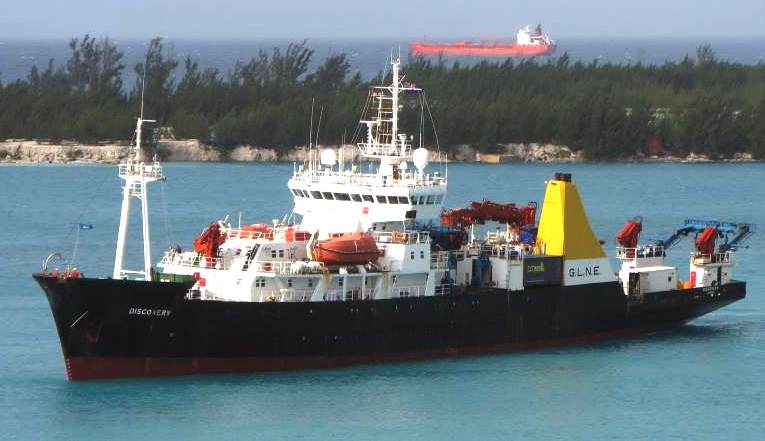
RSS DISCOVERY
Ship Type: Research (converted cargo) vessel
Year Built: 1962
Length x Breadth: 90 m X 14 m
DeadWeight: 1520 t
Speed recorded (Max / Average): 10.4 / 9.5 knots
Flag: United Kingdom [UK]
Call Sign: GLNE
IMO: 5090660, MMSI: 233882000
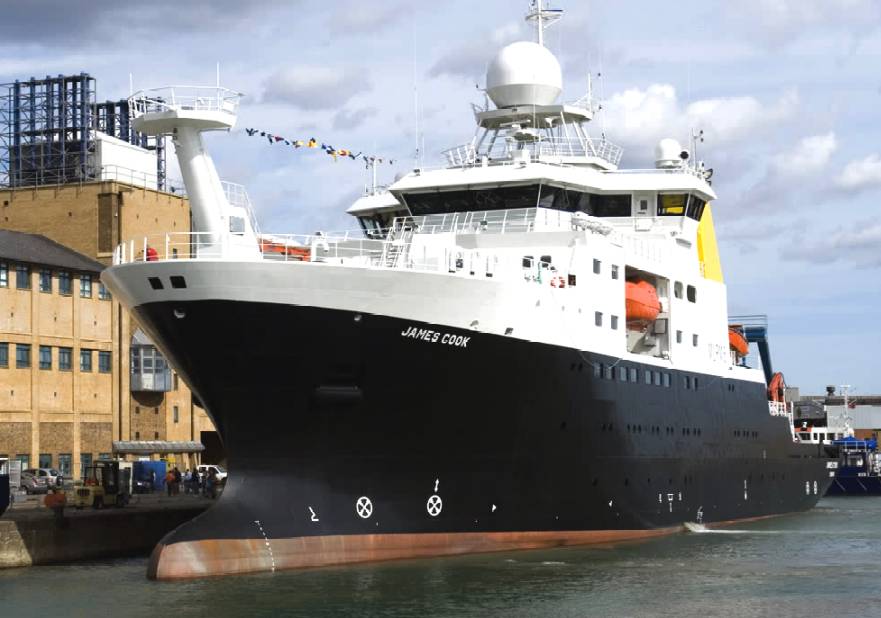
RSS JAMES COOK
FEBRUARY 2007
Royal Research Ship James Cook was commissioned by the Natural Environment Research Council. She was designed by norwegian ship designer, Skipsteknisk AS, and constructed in Norway. However, the hull was built in Poland. In 2006 she was registered in London, with her official christening by
HRH Princess Royal at the National Oceanography Centre, Southampton, in Feburary 2007. Costing £36million she is the newest British research vessel. In March 2007 she embarked on her maiden science voyage to the Mid Atlantic Ridge to study the fifteen-twenty fracture zone (FTFZ) which consisted of core drilling and sample collection from 16,000ft below the sea surface.
James Cook is a specially designed research vessel and has a variety of laboratories, store rooms, fridges & freezers, workshops and deck space especially for this reason. The laboratories are 'bare bone' so with every new science voyage all the equipment is installed for the duration. This allows a whole variety of research to be undertaken including biology, physics, chemistry, geology, geochemistry and the operation of remotely operated vehicles
(ROVs).
HRH The Princess Royal formally named the UK's new
royal research ship RRS James Cook in a ceremony held earlier this month at the National Oceanography Centre (NOC) in Southampton.
The latest addition to the National Environment Research Council's (NERC) fleet of oceanographic research ships is managed by the NERC's National Marine Facilities Division, which is based at the NOC. The ship is operated by professional mariners who provide a working platform and practical assistance to the scientists on board.
The new ship will carry scientists to some of the earth's most challenging environments, from tropical oceans to the edge of the
ice sheets. It has been designed as a multi-disciplinary scientific platform enabling investigations using precisely targeted instruments such as deep sea ROVs. It can accommodate large scientific parties and is highly flexible in the use of deck and laboratory space.
The ship was built by Norwegian yard Flekkefjord Slipp & Maskinfabrikk AS to a design developed by compatriots at Skipsteknisk AS. Since its delivery on time and within budget last August, RRS James Cook has undergone a programme of extensive sea trials to confirm its performance and safety at sea.
The ship sails on its first official voyage early next month to the Mid Atlantic Ridge, a massive underwater mountain range, where DP technology will keep it stationary whilst instruments are deployed to capture information about how the Earth's crust is formed.
Commenting at the ceremony, NERC chief executive Professor Alan Thorpe said, 'With oceans covering around three quarters of the Earth, ships like these are vital for the research community. They can reach places that would otherwise be impossible to explore. They allow us to discover micro-organisms that could, for example, be used to develop new antibiotics. And they help us to monitor and understand changes in the oceans that affect temperature and climate.'
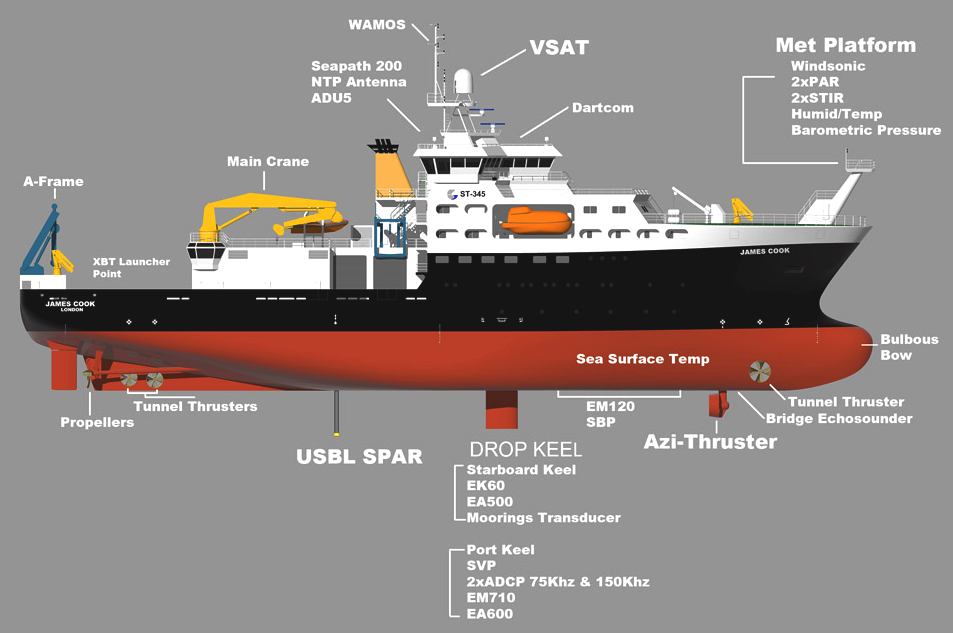
Displacement: 4500tonnes
Length: 89.20m
Bredth: 18.60m
Max Draft: 6.20m
Engine: Diesel-Electric
Max Powwer: 7080kW
Officers: 11
Crew & Technicians: 12
Scientists: 31
CONTACTS
National Oceanography
Centre
Southampton
University of Southampton Waterfront
Campus
European
Way
Southampton SO14
3ZH
Tel: 00 44 23 8059 6666
National Oceanography Centre
Joseph Proudman Building
6 Brownlow Street
Liverpool L3 5DA
United Kingdom
Tel: +44 (0)151 795 4800
LINKS
http://noc.ac.uk/
http://www.noc.soton.ac.uk/
http://www.etelive.org/content/contentetedetail.numo?id=53&i=3
http://www.maritimejournal.com/news101/royal_send-off_for_research_vessel
http://www.nerc.ac.uk/press/briefings/2007/03-jamescook.asp

The
SolarNavigator - SWASSH (Small Waterplane Area Stabilized Single Hull)
test model 2012. The
latest Solarnavigator is designed to be capable of an autonomous
endurance for surveying and patrol work. A demonstration world navigation set for
2015 if development proceeds according to schedule.






